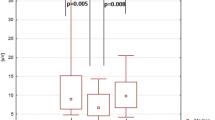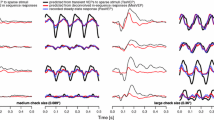Abstract
The frequency dependence of visual evoked cortical potentials under stimulation with a large field sine wave modulated light is investigated in patients with affections of the optic nerve. Neuritis and optic atrophy results in a strong reduction of high frequency responses (above 20 Hz). In neuritis the attenuation may be reversible. Amblyopia wether due to squint or occlusion does not affect the high frequency responses as compared to the normal eye in the same subject. V. E. C. P. are obtainable in patients with retinitis pigmentosa in whom the ERG is extinct. The more advanced cases however show a strong reduction of high frequency responses, the V. E. C. P. reduction is not dependent on the presence of cataract. The method can be applied to infant and small children without general anesthesia as fixation is not essential.
In the last few years the stimulation technology in visual evoked cortical potentials (V. E. C. P.) has been so far improved that cortical responses can be used even for refraction or color vision testing. Unfortunately for the many patients whose vision is reduced to the perception of shadows those sophisticated stimuli are but a tale told by a doctor, but nevertheless soundless and signifying nothing. We have been looking for a Stimulus to elicit V. E. C. P. sensitive to affections of the visual system but also insensitive to opacities of the ocular media or erratic fixation pattern. A homogenous blank field whose intensity is modulated in time with a strong modulation depth has been found to be very little affected by opacities of the ocular media and if the stimulus size is made large enough a lack of steady fixation is also unimportant. On the other hand a maximal V. E. C. P. amplitude to sine wave modulated light is usually obtained in a frequency range around the alpha rythm where a great amount of individual variability in response amplitude is due to an insufficient attenuation of the alpha rythm (Trimble & Potts 1975). With higher stimulus frequency the amplitude of the responses decreases but the individual and interindividual differences are much smaller. High frequency responses in normal subjects have been measured up to 80 Hz under very bright square-wave flicker whereas the responses to frequencies over 50 Hz are only obtained under very bright light stimulation (Gavrisky 1974, Abe Kojima & Iwata 1974).
The summation area for high frequency responses in the range of 45 to 55 Hz has been described as larger than for lower frequency stimulus with a loss of high frequency response when the stimulus field was reduced to less than 15° (Regan 1969).
We have measured the variation in V. E. C. P. amplitude as a function of stimulus frequency in patients with affection of the optic nerve and retina. We used a large stimulus field of 40°, modulated at 97%. In normal subjects V. E. C. P. of identical amplitude can be obtained with a field size of only 10° and a modulation depth of only 30% as with 40° and 97% modulation depth. In low vision patients however it is an advantage to saturate the response as the question asked is usually not whether any response is of normal amplitude or not but if it is present at all. The variable parameter used to obtain different responses, was the stimulus frequency.
Access this chapter
Tax calculation will be finalised at checkout
Purchases are for personal use only
Preview
Unable to display preview. Download preview PDF.
Similar content being viewed by others
References
Abe, H., Kojima, M. & Iwata, K., Flicker: VER studies on the flicker in normal subjects. Acta soc. Ophthal. japonicae 78, 4, (1974).
Abe, H., Kojima, M. & Iwata, K., Flicker and VER studies on the flicker VER in patients with lesion of the visual pathways. Acta ophtalmologicae japonicae 78, 9 (1974).
Adachi-Usami, E., Kellerman, F. & Makabe, E. J.: VER threshold in different stages of optic neuritis. Ophtalmic research 4, 284–296 (1973).
Asselman, P., Chadwick, D. W. & Marsden, C. D.,: Visual evoked responses in the diagnosis and management of patients suspected of multiple scerosis. Brain 98, 261–282 (1915).
Breukink, E. W.: De frequentiekarakteristiek van het menselijk oog onder normale en pathologische omstandigheden. Thesis. Drukkerij-Elinkwijk Utrecht (1962).
Halliday, A. M., McDonald, W. I. & Mushin Joan: Delayed visual evoked responses in optic neuritis. Lancet May 6, 982–985, (1972).
Lehmann, D. & Mir, Z.: Zur Methodik und Auswertung visuell evozierter Potentiale bei Verdacht auf multiple Sklerose. J. Neurol., in press (1976).
Milner Beryl, Regan, D. & Heron, J. R.: Differential diagnosis of multiple sclerosis by visual evoked potential recording. Brain 97, 755–772, (1974).
Trimble, J. & Potts, A.: Ongoing occipital rythms and the VER. I Stimulation at peaks of the alpha rythm. Invest, ophtal. July (1975).
Regan, D.: A high frequency mechanism which underlies visual evoked potentials. EEG et clin. neurophysiol. 25, 231–237, (1968).
Van Lith, G. H. M. & Mak, G. T.: A quantitative evaluation of the V. E. C. P. in optic neuritis.
Van der Tweel, L. H. & Verduijn Lunel: Human visual responses to sinusoidally modulated light. Electroenceph. clin, neurophysiol. 18, 587, (1965).
Van der Tweel, L. H. & Estevez, O.: Subjective and objective evaluation of flicker. Ophtalmologica 169/1, 70–81, (1974).
Author information
Authors and Affiliations
Editor information
Rights and permissions
Copyright information
© 1977 Dr W. Junk b.v. Publishers
About this chapter
Cite this chapter
Huber, C. (1977). Amplitude Versus Frequency Characteristics of Visual Evoked Cortical Potentials to Sine Wave Modulated light in Disease of the Optic Nerve. In: Lawwill, T. (eds) ERG, VER and Psychophysics. Documenta Ophthalmologica, vol 13. Springer, Dordrecht. https://doi.org/10.1007/978-94-010-1312-3_9
Download citation
DOI: https://doi.org/10.1007/978-94-010-1312-3_9
Publisher Name: Springer, Dordrecht
Print ISBN: 978-94-010-1314-7
Online ISBN: 978-94-010-1312-3
eBook Packages: Springer Book Archive




